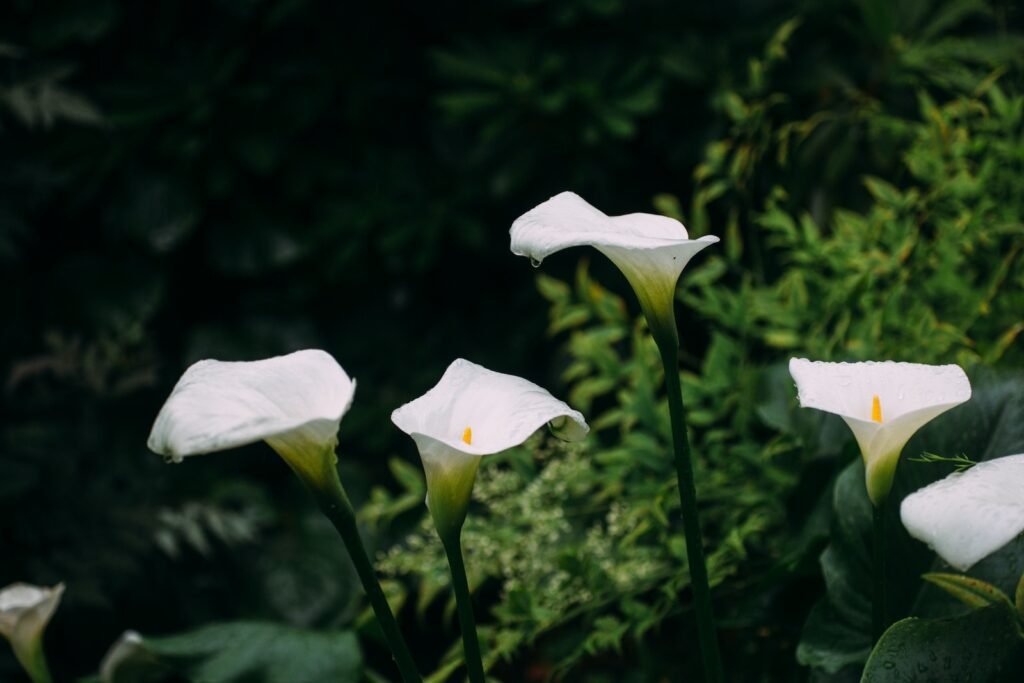calla lily (Zantedeschia spp.) are a genus of herbaceous flowering plants that belong to the Araceae family. These plants are native to South Africa and are popular ornamental plants grown for their showy flowers and attractive foliage. Calla lilies are known for their trumpet-shaped flowers that are usually white, yellow, or pink in color and have a distinctive spadix (central stalk) surrounded by a large petal-like spathe.
Calla lilies are also known by several other names, including arum lilies, trumpet lilies, and pig lilies. These plants are not true lilies, but they are often called lilies due to their similar appearance. In addition to their ornamental value, Calla lilies have been used for medicinal purposes and as a food source in some cultures. They are also popular in the floral industry and are often used in bridal bouquets, centerpieces, and other floral arrangements.
Calla Lilies in Art and Culture
Calla lilies have a rich history in art and culture. Here are some examples:
- Pablo Picasso, the famous Spanish painter, was known for his love of calla lilies, and he often featured them in his artwork. One of his most famous paintings, “Woman with a Flower,” depicts a woman holding a single calla lily.
- Georgia O’Keeffe, an American artist, also painted many calla lily artworks, such as “Calla Lilies on Red” and “Black and White Calla Lily.”
- In many cultures, calla lilies are associated with purity, innocence, and rebirth, and they are often used in weddings and other ceremonies.
- In ancient Greek mythology, the calla lily was associated with the goddess Hera, who were the queen of the gods and the goddess of marriage and childbirth.
- In some cultures, calla lilies are used as a symbol of death and rebirth, and they are often associated with funerals and mourning.
- Calla lilies have also been used in literature and poetry. For example, American poet E.E. Cummings wrote a poem titled “since feeling is first,” which includes the lines “the voice of your eyes is deeper than all roses/nobody, not even the rain, has such small hands / and yet the essence of all flowers, are you.” The poem is believed to be about a lover, but many people interpret the reference to “all flowers” as a nod to the beauty and elegance of the calla lily.
Type of Flower - Color
| Flowers Type | |
| White Flowers Name | Blue Flowers Name |
| Yellow Flowers Name | Pink Flowers Name |
| Purple Flowers Name | Red Flowers Name |
Types of Calla Lilies
There are many different types of calla lilies, each with its own unique characteristics. Here are some of the most popular types:
- White Calla Lilies – These are the most common type of calla lilies, and they are known for their pure white color and elegant shape.
- Black Calla Lilies – These calla lilies are not actually black, but they are a deep maroon or purple color, and they have a dramatic and striking appearance.
- Pink Calla Lilies – These calla lilies come in shades of pale pink, hot pink, and even dark pink. They are often used in romantic or feminine floral arrangements.
- Yellow Calla Lilies – These calla lilies have bright yellow blooms and are often used to represent happiness, joy, and friendship.
- Miniature Calla Lilies – These are smaller versions of the traditional Calla lily, and they come in a variety of colors. They are perfect for use in smaller floral arrangements or as accent flowers.
- Bi-Colored Calla Lilies – These calla lilies have a unique and striking appearance, with two different colors on the same flower.
- Picasso Calla Lilies – These calla lilies have a white base with purple speckles or stripes, and they are named after the famous painter Pablo Picasso.
- Crystal Clear Calla Lilies – These calla lilies have a unique and translucent appearance, with a delicate, crystal-like texture.
- Flame Calla Lilies – These calla lilies have a vibrant and fiery appearance, with bright orange and red blooms.
- Green Goddess Calla Lilies – These calla lilies have a unique and unusual appearance, with pale green blooms that look almost like they are made of glass.
- Choose a location with bright, indirect light. Avoid direct sunlight, which can scorch the leaves.
- Keep the soil evenly moist, but not waterlogged. Allow the top inch of soil to dry out slightly before watering again.
- Water deeply and allow excess water to drain away. Empty the saucer beneath the pot to prevent the plant from sitting in water.
- Fertilize once a month with a balanced fertilizer, such as 10-10-10.
- Keep the humidity high by misting the leaves with water or placing a tray of water near the plant.
- Avoid drafts and sudden temperature changes, which can stress the plant.
- Deadhead spent blooms regularly to encourage more flowers.
- Remove any yellow or brown leaves promptly to prevent the spread of disease.
- Repot the plant every 2-3 years, or when it outgrows its container.
- Watch for signs of pests, such as spider mites or mealybugs, and treat promptly with insecticidal soap or neem oil.

